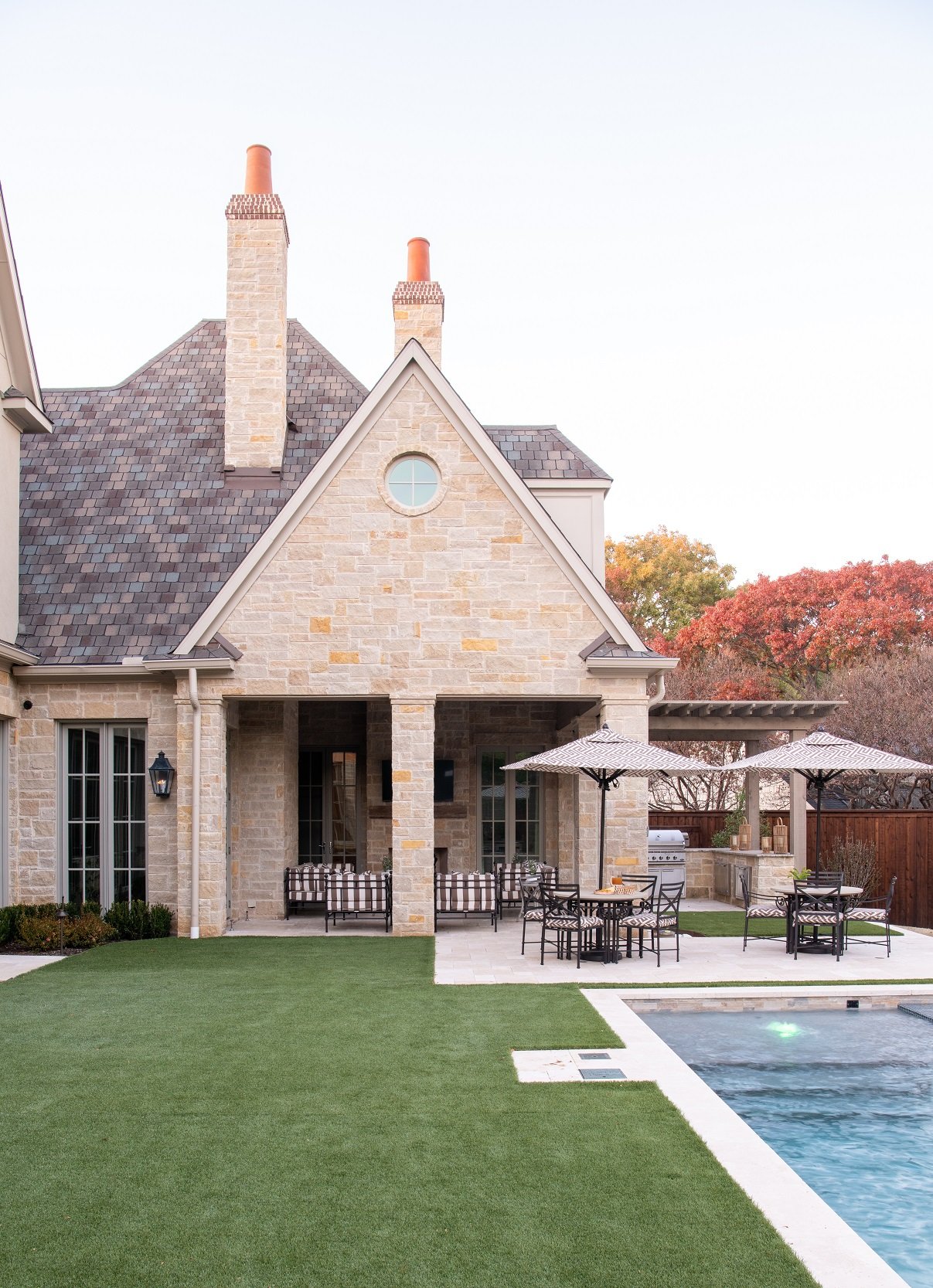We used matching fabrics for the chairs and umbrellas to give this poolside outdoor living area a consistent look.
Over the years, I’ve had the opportunity to watch pool trends come and go and help choose pool shapes, finishes, and pool furniture for my Dallas clients. Here are some of the things I’ve learned about pools during my career as an interior designer.
1. Determine How You’ll Use Your Pool
First, if you’re thinking of building a pool, you need to list the different ways you plan on enjoying it. Do you want your pool to be for family recreation, personal fitness, entertaining, or a combination of all of these?
Families with children might want their pool to have a continuous underwater shelf or a pool bench. A lap pool needs to be rectangular and very large. If you are primarily using your pool as a party setting, you should ask yourself: will you want a fire pit or fireplace nearby? What about an outdoor kitchen, bar, or cabana?
2. Take a Look at Your Site
It’s important to ask a pool design expert to do a site analysis based on your property. This can help prevent your project from running into snags later. Big leafy trees and pools are a bad combination: you’ll constantly be cleaning out leaves. Pecan trees are prone to a disease call pecan scab in which the leaves develop black spots. When the leaves come in contact with other surfaces, like your pool deck, they leave behind a black film that is very difficult to get rid of.
3. Choose Your Pool Type and Shape
Vinyl and fiberglass pools are not commonly built in Texas because of soil conditions, so if you live in Texas, concrete is likely your best choice. The shape of the pool should also complement the architecture of your house. For example, for a modern house, I would design a sleek and simple pool. Be careful about “trendy” pool designs. A pool that is trendy now can date the house later.
4. Select Water and Deck Color
As far as color goes, I think that a pretty blue or aqua is the best pool color. Light-colored decks reflect light, while dark pool decks absorb heat. One of the concerns with light-colored decks is that they stain easily, but a good sealer can prevent this. Choose a durable tile that is easy to clean for the inside edge of your pool.
5. Plan for Pool Extras
This pool on a University Park home that we designed features an integrated hot tub with matching tile.
A spa or hot tub can be either integrated into a pool or built separately. I think it’s better to integrate the two as long as the spa will blend with the pool’s design. When it comes to water features, I personally love deck jets that arc and crisscross each other.
6. Add Outdoor Furniture
Pool furniture needs to have complementary colors to the home’s exterior. Although I often mix and match different kinds of furniture in my interior design, with outdoor furniture I almost always use all matching sets, with the same metal finishes and same fabric on the large cushions and umbrella. I introduce variety with contrasting decorative pillows or accent tables (like faux bois accent tables or garden stools), but that’s about it.
7. Do Your Research
It’s easy to get excited looking at brochures of beautiful pools, but think carefully before you take the plunge. Although a pool can help sell your house, homes with poorly made pools are harder to sell than homes without them. Look for pool companies in your area that have been in the business for a minimum of fifteen to twenty years and have a good reputation.
If adding a pool to your home is just one part of your home building or home renovation project, you can also bring in an interior designer for their input. An interior designer usually has a lot to say about pools: after all, they want to make sure that your pool not only looks beautiful, but is the perfect match for your house. To schedule a free consultation with us, send an email to info@chambersinteriors.com or call our Dallas office at 214-651-7665.


